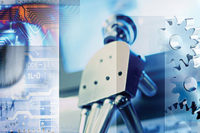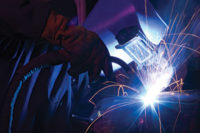Versatility, portability, flexibility and low cost are key reasons why the arc welding process is widely used. Due to the various ways that this technique is applied in industries and architectural structures, it is crucial that weld integrity is maintained and that strict standards and quality are enforced. Welding and nondestructive evaluation (NDE) go hand in hand, and welding techniques would not be acceptable if there were no way to evaluate the resulting welds without destroying them. At the same time, if it were not for the wide need for welding, the demand for NDE would be greatly reduced.
Defects usually are classified into two categories: major flaws that can cause failure and minor variances that have no effect on the manufactured part. Today’s manufacturers are constantly managing material costs, yield, efficiency and quality to improve profitability, acquire and retain clients and mitigate liability costs. The costs of shipping defective product are difficult to quantify. However, the risks and costs associated with repairs, loss of customers, or subsequent legal action are potentially huge—they are the main impetus for installing NDT equipment in the first place.
Whether arc welding is used in the building of aircraft, building structures, or ships, the purpose of weld process monitoring is to make sure that the process of quality control/quality assurance (QC/QA) is carried out. Weld process monitoring is a real time QC/QA method of testing to check for defects or poor quality work, signaling any work that does not meet user defined control limits either arbitrarily defined or by codes, standards or specifications. The control limits can also be determined by established business rules and economic metrics that are tied directly to the production process.
The beauty of real time monitoring is the availability of information that is captured and summarized for the operator, production and quality personnel. This feedback allows one to define a set of parameters within a tight specification window. However, it is also not enough to simply monitor. A user must collect data and then mine the data when events occur to establish the cause and effect relationship. The cause and effect relationship can then be turned into a QA method to reduce the likelihood of the event occurring again.
Weld process monitoring historian also builds traceability so that each part has its own defined weld signature, which can be turned as part of the QA report. Last but not least, the collected information is a valuable source of knowledge that can be used to move new employees up the learning curve much quicker. A few of my clients aptly put it this way: “We need to capture the tacit knowledge of experience so that when they retire, the weld procedure can be easily transferred. Weld and process monitoring allows us to normalize the employees. By following a defined weld procedure and routine, we can reduce the variance in production yield.”
In the following section, several options for weld process monitoring are mentioned. These are techniques which have come into the market in the past two to three years. There isn’t one system to fit all client needs. In a lot of cases, more than one type of system is ideal since they look for different things. The common thread between these techniques is the underlying principle of a simple visual display for the operator with an intuitive back end monitoring package. The visual display is there for the operator to see and quickly process what is happening and take corrective action.
Infrared systems and the associated software are sophisticated enough to monitor the thermal characteristics of the weld in real time. This type of system monitors the thermal properties of the heat signature to help a company understand what is happening at the weld. The beauty of this system is the visual of the welded thermal field as shown on the bottom section of Figure 3. The bright yellow zones are the hottest parts of the weld and trend to an orange/red color in the cooler regions. The image is an example of lack of penetration which was not detected by conventional NDE methods. The disturbance in the thermal field was easily picked up as the trend line passed the control limit. An alert was generated in real time and the data collected.
Offline, the data was mined and analyzed. QA was able to determine that the root cause was by an unstable weld arc causing a intermittent short. The company was very pleased with the efficiency at which the production and quality team arrived to the cause and effect relationship. This examples illustrates the importance of real time weld process monitoring and when the tool is used properly, corrective action is quickly applied to remove the disturbance.
Laser based imaging provides non contact means to examine the surface profile of the weld bead. In real time the welding process can be monitored and examine for defects as the welding occurs. The most common types of weld defects that can be detected include: misalignment, undercut, underfill, concave, convexity, overlap, burn through. Process parameters such as Frequency, Amps, Volts, Gas rate, line speed, weld temperature can also be monitored and recorded.
Like the previous system user defined limits trigger the onset of a disturbance in the weld in real time. The trigger initiates a data capture mode which can then be charted for a better understanding of the issues at hand. A sample distribution curve can quickly allow the personnel to see that the parameters are within the sigma control limits.
The strength of this system is the ability to plot weld profile data to weld process data. For example, there is a direct correlation between weld bead height and weld temperature. Therefore monitoring the weld temperature and creating correlation tables to weld bead height yields valuable information for situations when the weld may look good, but the data says otherwise.
Weld visualization has been around for many years. In the past three years developments in camera technology has made it possible to view the weld with greater clarity. This has also opened up new possibilities to extend the welding camera beyond that of a visual tool. Systems exist today whereby the weld process ( amps, volts, gas, speed) are data logged and time stamped with the welding video. The user defines the upper and lower bounds of the process and when an event occurs, the welding video is recorded. Therefore the database contains the weld process data and a visual of the weld. A user can then play back the welding video and the curve data simultaneously. The process variables are constrained by control limits and as a result, an error is quickly detected. The QA personnel can then open the historian and play back the sequence to see exactly what has happened both visually and via the trend line data.
In the realm of laser welding, the welding camera is providing real-time information about the quality of the weld. Here, the traditional use of a camera system as an inspection tool is being applied to detect anomalies immediately after the weld. This has significant benefit to stop the process of welding before additional value is added to the part being fabricated. Here the system is taught a number of weld masks which are then stored as a library. Upon each weld completion, the current image is compared to the library in a fraction of a second. Again, with this approach, monitoring the power input and mapping the power input to control limits provides real-time insight into cause and effect relationships of the weld that occurred.
In Figure 1, we have insufficient laser power which resulted in a lower intensity value inside the masked region of interest.
In the example in Figure 2, we have insufficient fusion as detected in the image on the right. The weld seam width is too wide which indicates a non heat penetration condition.
This technique is being pushed over into the traditional arc welding, where the weld puddle is the region of interest. The ideal characteristics of the weld pool are well known. The attempt that is being considered is to utilize the weld pool characteristics as a means to apply indicators for weld quality. By simultaneous monitoring of the weld parameters, closed loop feed back to the welding process is possible to realize a homogenous weld.







